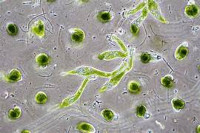Evaluation of Heavy Metal Contamination in Chlorella vulgaris in the Southern City of Iraq Using Scanning Electron Microscopy and the Risk Assessment http://www.doi.org/10.26538/tjnpr/v7i12.6
Main Article Content
Abstract
Heavy metals pose a significant threat to aquatic environments due to their widespread industrial use and untreated disposal into water. Studies have demonstrated that algae can effectively absorb and accumulate heavy metals from polluted areas. The present study investigated the ability of the green alga, Chlorella vulgaris to accumulate some heavy metals. Chlorella vulgaris was isolated and identified from water samples collected from the surface water of the Euphrates River. The alga was treated with different concentrations (10, 15, 20, and, 25 mg/L) of heavy metals (copper, lead, cadmium, and cobalt) for 14 days. Scanning electron microscopy (SEM) was used to examine the surface morphology of algae. The results showed that C. vulgaris can accumulate heavy metals. Cobalt was the highest accumulated metal followed by low accumulated metals of copper, lead, and cadmium. Heavy metal concentrations of cobalt, copper, lead, and cadmium were accumulated in C. vulgaris with concentrations of 0.57, 0.12, 0.05, and 0.02% dry weight, respectively. Cadmium was the most toxic metal to cell shape and contents, followed by cobalt. However, copper and lead showed no effect. The findings of the study suggest that C. vulgaris can be used in bioremediation to remove heavy metal contamination from water.
Downloads
Article Details

This work is licensed under a Creative Commons Attribution-NonCommercial-NoDerivatives 4.0 International License.
References
Warouw F, Mambo C, Pertiwi JM, Warouw V, Bara RA. Identification of active antioxidant compounds with neuro-protective effects in Kora-kora coastal macro-algae. Trop J Nat Prod Res. 2022; 6(12):2025-2028. http://www.doi.org/10.26538/tjnpr/v6i12.21
Al-Taee IA, Razzaq WS, Al-Khafaji AS. The role of algae in bioremediation of heavy metals. Al-Kufa Univ. Bio J. 2022; 14(1): 86-98.
Hlail SH. Heavy metals accumulation in trees grown in urban and rural Areas. Geosci Environ Protec J. 2019; 7: 69-75.
Sati M, Verma M, Bora M, Rai JP. Potential of algae in bioremediation of heavy metals: A review. Bull. Environ. Pharmacol Live Sci. 2016; 5: 86-97.
Chai WS, Cheun JY, Kumar PS, Mubashir M, Majeed Z, Banat F, Ho S, Show WS. A review on conventional and novel materials towards heavy metal adsorption in wastewater treatment application. J Clean Prod. 2021; 296: 126589.
Al – Imarah F, Ghadban R, Al – Shaway S. Levels of trace metals in water from southern part of Iraq. Marina Mesopotamica. 2000; 15 (12): 365 – 372.
Stein JR. Hand book of phycological methods. Cambridge Unv. Press. Cambridge, U K.1973.
Rescott G. Algae of the western great lake area. Elion C., Brown Co. Pub. Dugugue, Lowa, USA .1975.
Weidman V, Walne P, Tainor F. A new technique for obtaining axenic culture of algae. Can. J Bot. 1984; 42: 958–959.
Tomaselli L, Giovannetti L, Margheri M. The mechanism of trichome breakage in Spirulina platensis and Spirulina maxima. Ann Microbial. 1981, 31: 27 - 33.
Yadav S, Chandra R. Detection and assessment of the phytotoxicity of residual organic pollutants in sediment contaminated with pulp and paper mill effluent. Environ Monit Assess. 2018; 190(5): 581–591.
Álvaro B, Marina S, Juan M, Antonio S, Isabel E. Scanning electron microscopy coupled to an energy dispersive x-ray detector to study copper removal on different phototrophic microorganism. current microscop contributions to advances in Sci. and Tech. (A. Méndez-Vilas, Ed. 2016, 100p
Malik MJ, Abdul wahab RA. Determination of bioactive compound and antibacterial of Spirulina sp. extract. Ann RSCB. 2021; 25 (6):132-144.
Khadija AT, Abdual-wahab RA, Fadhil AM. Effect of ethanolic extract of Chlorella sp. on Entamoeba histolytica parasite in vivo. Plant Arch J. 2020; 20 (1): 1975-1978.
Pavasant P, Apiratikul R. Sorption isotherm model for binary component sorption of copper, cadmium and lead ions using dried green microalga, Caulerpa lentillifera. J Chem Technol Biot. 2018; 119: 135 – 145.
Lamas EM, Soares MJ, Oliveira MM. Effect of cadmium on growth Euglena graeilis membrane lipids. Braz J Med Biol Res. 1996; 29 (8): 941-949.
Suaad HA, Abdul-Wahab RA. Effect of UV-B radiation on the content of pigments and mineral elements in Cladophora graminea and Spirogyra deadaleoides algae. Indian Ecolo J. 2020; 47s (12):221-224.
Munda IM, Hudnik GV. Growth response of Fucus vesiculosus to heavy metals, singly and indusal combination, as related to accumulation Botan.1986; 15(3):18-23.
Dwivedi S. Bioremediation of heavy metal by algae: Current and future perspective. J Adv Lab Res Bio. 2012; 3(3): 229-233.
Suaad HA. The effect of thiame thoxam on the chemical components of Lyngbya aerugineo-coerulea. Plant Arch J. 2020; 32(5):456-462.


